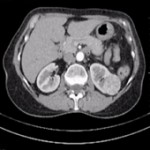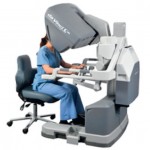Editorial: VR simulators can improve patient safety
You wouldn’t expect the pilot of the aeroplane in which you fly to the EAU or AUA meeting to be a novice who was training on the aeroplane that you were being transported in! Similarly, patients undergoing robot-assisted surgery do not expect to be the “guinea pigs” upon which trainee surgeons move up the learning curve of surgical experience. Sometimes, however, they are.
Surgical simulators offer the means for surgeons to gain experience before moving to operating on actual patients. However, the publication from Guy’s and St Thomas’s illustrates how little research has been done yet to confirm that outcomes are improved by such a move.
Patient safety is a “buzz word” at present, especially after the report of Robert Francis QC on the Mid-Staffordshire NHS Trust disaster. It seems probable that virtual reality (VR) simulators can improve safety, not only by improving technical skills, but also by enhancing non-technical “human factor” responses.
Much work needs to be done to provide the VR training facilities and ensure access to them for all urology trainees. Once they are in place studies will be needed to confirm their value. In a world where doctors and Trusts are facing a tidal wave of litigation there seems little doubt that this is the way ahead.
Roger Kirby
The Prostate Centre, London W1G 8GT





Do we really need to prove that VR training has value? Did the airplane industry perform studies to confirm the value of their simulators?
Agreed, logic would dictate that simulation training is likely to progress the trainee along the early stages of the learning curve, and in fact these studies have proven educational value. However in an era of evidence based medicine/education/training we should investigate which simulator is optimal. After all, simulators themselves are expensive and we are in a difficult economic period. Trainers / curriculum developers / deaneries are going to look to invest wisely and will want to know which is the best available option in the marketplace.
Intuitively, the use of simulators are going to become an important part of training. As things are right now, I no longer allow my trainees to touch a patient for PVP surgery without first having done the basic modules on the excellent simulator that has recently become available. The skill level of my trainees who have used a simuator and wet lab versus wet lab alone before attempting any PVP surgery has so far demonstrated such stark differences, that I do not need a trial or published research to prove or convince me of its value. Just in the same way that I do not need a trial to convince me that a trainee should master basic cystoscopy before attempting a TURP. Lets follow the lead of the aviation industry and introduce quality simulators as a priority – as we see the trainees working week get shorter and theatre list turnover getting slower and slower, we need everything in our favour to improve the efficiency of training.
I have just written to the Board of Urology (who administers training in Australia and New Zealand) asking them to consider providing training credit to trainees who have spent time on simulators – should be worth as much if not more than credits given for holding a retractor or doing an operation poorly without adequate supervision. I am looking forward to seeing how they will tackle this issue.
Agree with HW.
All training modalities in high-risk professions have been extensively validated before implementation into practice.
The airline / flight simulators are validated and with regards to research they are much more ahead of us i.e. clinicians from craft disciplines. Simulation is an integral part of airline pilot training and is totally evidence based.
In my opinion, healthcare simulators should never be used without validation of contents, educational impact and feasibility.
A few references:
J. Banks. 1989. Testing, understanding, and validating complex simulation models. In Proceedings of the 21st conference on Winter simulation (WSC ’89), Edward A. MacNair, Kenneth J. Musselman, and Philip Heidelberger (Eds.). ACM, New York, NY, USA, 549-551.
Dillard, Archie E. “Validation of advanced flight simulators for human-factors operational evaluation and training programs.” Foundations 2 (2002): V7V.
The training system in UK has undergone considerable changes. Medical graduates are being rushed through to enter into the specialist surgical training which is relatively short and has become shorter in terms of numbers of hours worked because of the European Working Time Directive. Problem has been compounded by the rapid evolution of new technologies and increasing concerns about patients’ safety. It has become vital to consider alternatives to work based training. This not only applies to surgeons in training but also to those who have crossed that barrier but wish to embrace new technologies.
Let me clarify one misconception about simulation. Simulation is not synonymous with virtual reality (VR) simulators. It is this misunderstanding which leads to the outright rejection of the simulation concept as unaffordable. We have witnessed the introduction of the simulation with evolution of laparoscopic surgery. Trainees and practicing surgeons are routinely undergoing dry lab, wet lab training and performing a certain no of procedures under mentorship before independent practice. This trend developed after numerous serious adverse events during the learning curve of laparoscopic surgeons. We must expand this practice to all areas of our surgical discipline.
Simulation is a discipline in itself with wide range of training tools for technical skill training and human factor simulation (Non-Technical Skills). Non-technical skills are as important as technical skills if not more important. The Simulation and Technology enhanced Learning Initiative (STeLI) project sponsored by the London Deanery is good example of simulation in practice. This included part task and non-technical skill training. STeLI model is serving as a template for the national SIMULATE project initiated by the British Association of Urological Surgeons (BAUS). This project is aimed at the introduction of simulation in urological training nationally and to answer the un-answered question of predictive validity of the simulation over next five years. I expect by that stage this question may even become irrelevant!
We cannot ignore the cost of implementing such programmes. Introduction of new technologies is unavoidable particularly in Urology. However, if urologists aspire to remain at the forefront of embracing new technologies which are very expensive, it would be worth investing in piece of kits for simulation training. The cost of new technologies is many times higher than respective simulators. The industry should be persuaded to provide such kits with new devices. We must not forget that the cost of treating complications is enormous and every possible measure should be taken to reduce the risk. It may not be realistic to achieve the safety standard of airline industry which built the first simulator in 1911 and is thus over 100 years ahead of us but we must aspire to improve our performance to the highest possible achievable standard.
The Specialist Advisory Committee (SAC) in Urology has already submitted simulation curriculum to the General Medical Council (GMC) for its approval. The GMC is planning to mandate simulation in urological training in a phased manner over next 3 years. BAUS and SAC (Urology) should be proud to have taken lead ahead of other urological organisations in this initiative to enhance patients’ safety.
Muhammad Shamim Khan OBE FRCS (Urol) FEBU
Consultant & Reader in Urology, Guy’s & St Thomas’ Hospital London
Become familiar with the operational aspects of the da Vinci surgical robot does require some practice and training but also is rather easy. Performing the surgical procedures properly is another matter. The complications that typically occur are from operator not machine error. Simulators can help a surgeon become familiar with the robotic instrument but whether they can facilitate surgical performance is uncertain. The common analogy between an airline pilot and a surgeon goes only so far.
Another misconception about value of simulation in surgical training- it is an adjunct not an alternative to training in theatre. Airline industry has taken safety to a very high standard. The risk of dying in a plane crash is estimated to be 1:10 million. Risk of serious adverse event or death during hospital admission is 1:300. Statistics is glaringly obvious to appreciate that we can learn from others and not necessarily need more disasters to happen before we change our stance.